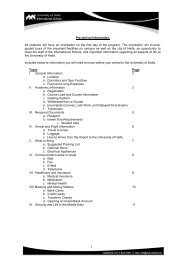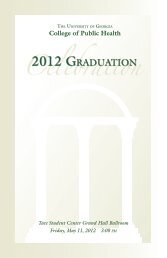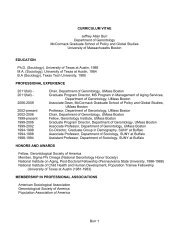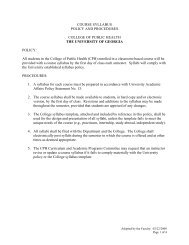MEASUREMENT MANUAL - College of Public Health - University of ...
MEASUREMENT MANUAL - College of Public Health - University of ...
MEASUREMENT MANUAL - College of Public Health - University of ...
Create successful ePaper yourself
Turn your PDF publications into a flip-book with our unique Google optimized e-Paper software.
Positive Behavior Scales<br />
DESCRIPTION<br />
RESPONSE<br />
FORMAT<br />
INTENDED<br />
RESPONDENTS<br />
SCORING AND<br />
DIRECTION<br />
RELIABILITY<br />
MISSING<br />
VALUES<br />
NARRATIVE<br />
The Positive Behavior Scales was designed to measure the self-reported<br />
frequency <strong>of</strong> exerting or receiving positive behaviors during the 30 days prior<br />
to the survey. The scales were developed based on student and teacher<br />
input on most frequent positive children’s behavior in the classroom, as well<br />
as expected positive behaviors. Each scale is composed <strong>of</strong> 10 items. The<br />
time frame is the<br />
0 = Never<br />
1 = Once or twice<br />
2 = About once a week<br />
3 = Several times a week<br />
Upper elementary and middle school students, grades 3 to 8.<br />
High values indicate higher frequency <strong>of</strong> positive behaviors among students.<br />
In a sample <strong>of</strong> upper elementary students (n=206), the internal consistency<br />
<strong>of</strong> the scores, as measured by Cronbach’s alpha, was .90 (range by gender<br />
and race = .82 to .91) for being the recipient <strong>of</strong> positive behaviors and .91<br />
(range by gender and race = .89 to .92) for self-reported positive behaviors<br />
Scale scores can be calculated if at least eight items are nonmissing.<br />
The Positive Behavior Scales measure the frequency <strong>of</strong> exerting or receiving<br />
positive behaviors during the month prior to the survey. The Positive<br />
Behavior Scales are composed <strong>of</strong> two subscales: the first subscale assesses<br />
positive behaviors the student has experience from classmate, and the<br />
second subscale assesses positive behaviors the student has performed.<br />
Responses range from never to several times a week, in a 4-point scale.<br />
Item scores are added; thus, each scale ranges between 0 and 40 points.<br />
The scale includes behaviors such as complimenting, being polite, helping<br />
with something or <strong>of</strong>fering to help, sharing, and acting friendly.<br />
REFERENCES This measurement manual.<br />
January 2009 13
















